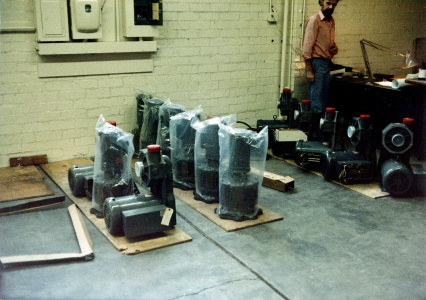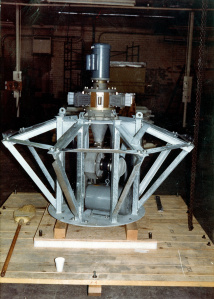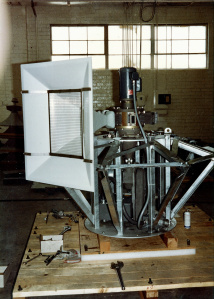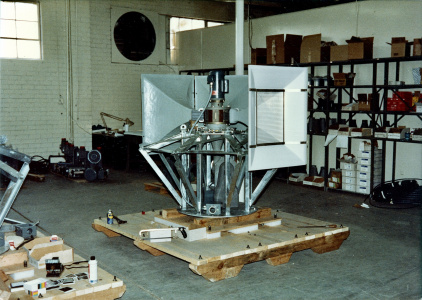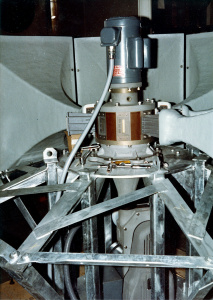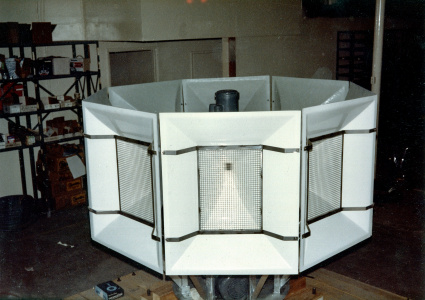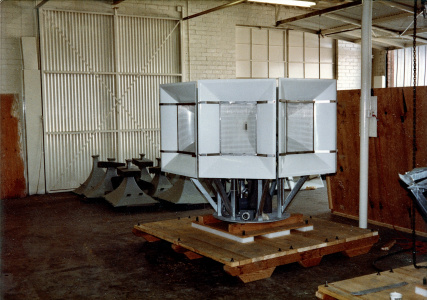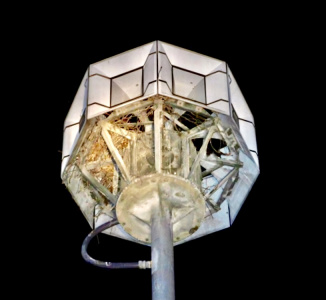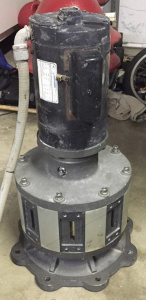Model 120: Difference between revisions
No edit summary |
TheCamWheel (talk | contribs) mNo edit summary |
||
| (16 intermediate revisions by one other user not shown) | |||
| Line 1: | Line 1: | ||
{{Infobox siren | {{Infobox siren | ||
|image =[[File:Model 120.jpg|Unit installed on a wood pole]] | |image =[[File:Model 120.jpg|Unit installed on a wood pole]] | ||
|company= Southern California Edison | |company= Southern California Edison | ||
|produced= | |produced= 1982-1988 | ||
|type=[[ | |type=[[Electromechanical]] | ||
|output=120 | |output=120 | ||
|hertz = 240 or 300 | |hertz = 240 or 300 | ||
|neigh = 2 (Rotor) 10 (Blower) | |neigh = 2 (Rotor) 10 (Blower) | ||
}} | }} | ||
The | The ''' SoCal Edison (SCE) 120 ''' or ''' Model 120 ''' was a 120 dB low tone supercharged electromechanical siren designed in house by Southern California Edison for use within the 10 Mile Emergency Planning Zone (EPZ) for the ''' [[San Onofre Nuclear Generating station]] '''. | ||
== History == | |||
Siren | The Model 120 was originally created in 1982 as a custom built siren for the SONGS plant, which had strict requirements for its siren system. SONGS had gone through two other systems before this point, with a system of 39 [[Sentry Siren Incorporated]] [[10V]]'s, [[5V]]'s, and [[3V8]]'s installed in August 1981 and tested January 25th thru 27th, 1982. The Sentry sirens were found to perform terribly compared to what was advertised, leading to the sirens being removed an replaced. SONGS would then install a new system of 39 [[Federal Signal]] [[STL-10]]'s with those being installed by April of 1982 and tested in May of the same year. While the STL-10's performed significantly better than the Sentry sirens did, they still didn't meet the plant's needs. The only sirens on the market with enough range that would meet the plant's needs at the time were rotational sirens, but SONGS wanted to use exclusively omnidirectional sirens. So, they decided to design and create their own siren to meet their requirements. | ||
[[File:Model 120 prototype being mounted to an existing STL-10 pole for range and output testing in 1982.jpeg|thumb|left|upright|Model 120 prototype being mounted to an existing STL-10 pole for range and output testing in Summer 1982.]] | |||
Starting in around June 1982, Model 120 prototypes started to be constructed and tested, with the final designed units being completed in October 1982. Originally, the plan was after the first Model 120's were installed, a total of 52 additional Model 120's were going to replace the existing [[Federal Signal]] [[STL-10]]'s and making the system entirely Model 120's. This plan was dropped shortly afterwards due to the increasing delays and costs caused to the plant by not having a ready siren system by 1981 which was the original year planned for the plant's 2 newly constructed reactors to begin operating. Units #2 and #3 were ready to begin operation, but because the siren system was inadequate they couldn't begin operation until the Model 120's were installed. This caused a delay for over a year, as it also happened around the same time the NRC required nuclear plants to have siren systems. This also meant the plant's existing Unit #1 could not be restarted until the siren system was ready. | |||
There were 22 of these sirens produced, with one being never installed and put into storage as a spare. 16 of these were installed in October 1982 to add into the system of STL-10's, 8 of which indirectly swapped out with Model 120's with another 8 being brand new installs. 5 additional sirens were installed in 1988, one of which replaced a [[Federal Signal]] [[Thunderbolt]] that was an existing Civil Defense siren. | |||
[[ | After the Model 120's went up, in order to end the delays of the siren system not being up to par, SONGS opted to just keep the remaining [[Federal Signal]] [[STL-10]]'s and add 21 Model 120's in areas that need coverage and to swap out specific STL-10 sites that had the worst range compared to the others, (First 8 sites), to get the EPZ up to code for the plant's reactors to start. After a successful system test on May 4th, 1983, the plant's new reactors began operation shortly afterwards with Unit #2 starting on August 8th, 1983, and Unit #3 on April 1st, 1984, as well as Unit #1 being restarted. These delays, and the cost of the sirens themselves cost the plant over $1 million dollars. | ||
== Other Information == | |||
[[ | For around a decade, they were thought to be "Toshiba" sirens, because they were pneumatic and people just assumed they were made by Toshiba which made pneumatic sirens. The Model 120 is a Supercharged Electromechanical siren, but also more or less acts like a pneumatic siren due to the rotor lacking any vanes, meaning it requires an external air source to produce any meaningful sound, such as the [[Thunderbolt]] and [[Hurricane]]. The sound is created by a 4-port (later 5-port) single tone rotor, which spins inside the stator, which acts as a chamber to contain the air inside. The rotor is driven by a 2 Hp TEFC motor that runs at 3450 RPM. The siren has an 8-port stator with narrow ports, and the sound is then projected by 8 large fiberglass horns attached to the stator. The siren makes use of a belt driven Paxton centrifugal blower, that uses a 10 Hp TEFC motor which sits below the siren's head to force pressurized air up into the rotor. The 4-port units reached a frequency of 240 Hz (480 Hz without the blower) and the 5-port units reached 300 Hz. The rotor and stator are both coated in Teflon, which helps seal the air in and prevent leaks, while also helping to protect them from corrosion from the salty air. The rotor is 9.75 inches in diameter and including the stator, which it alone is over 2 inches in diameter, is in total 11.75 inches in diameter. | ||
[[ | By June of 2004, the plant began discussing a system replacement project due to the sirens suffering from advanced corrosion and degrading reliability due to the system's proximity to the ocean, along with the system "aging", and a year later starting In November 2005, (a month after the annual siren test), the Model 120's and the STL-10's started to be gradually removed and replaced, and by February 2006 all have been replaced marking October 26th, 2005 as the final test of the original system, as well as the end of the one of a kind original system that stood out from all other Nuclear plant systems. [[Whelen Engineering]] [[WPS-2800 series|WPS-2810]]'s and [[WPS-2800 series|WPS-2806]]'s were installed in their places. The 2810's went in place of the Model 120's and the 2806's went in place of the STL-10's. | ||
These new electronic sirens have battery backup, are less maintenance due to their resistance to corrosion and no moving parts, and have similar ranges to the original system such as the 2806's having better range compared to the STL-10's, and the 2810's having close to the same range but about 2,000 feet less range compared to the the Model 120, but still enough range to cover the EPZ. These new sirens met the strict requirements of the plant without the need to specifically design a new siren as by the 2000's, there was commercially produced omnidirectional sirens that have close to the same range as the Model 120 and as well have better range then the STL-10's. | |||
After all the old sirens have been removed and replaced, SONGS sold 23 of the STL-10's to Curry County, Oregon to be used as tsunami sirens, 8 of which were installed, and the Model 120's and remaining 5 STL-10's are believed to have been scrapped, but its unknown if they were, or went somewhere else but hasn't been discovered. The only Model 120 that is known and remaining is in private possession currently under restoration to be brought back into operating condition. | |||
== Gallery == | |||
<gallery mode=packed heights=200px> | |||
7 Model 120 heads and blowers.jpeg|7 Model 120 heads and blowers prior to being assembled. | |||
Assembled unit without horns.jpeg|Assembled unit without horns. | |||
Horns being attached and conduits ran to main junction box.jpeg|Horns being attached and conduits ran to main junction box. | |||
5 out of the 8 horns attached with another unit being assembled off to the left.jpeg|5 out of the 8 horns attached with another unit being assembled off to the left. | |||
Closer view of the head with the siren 95% assembled.jpeg|Closer view of the head with the siren 95% assembled. | |||
Fully assembled Model 120.jpeg|Fully assembled Model 120. | |||
Fully assembled Model 120 with the other 6 being assembled and crated up to be transported to San Onofre Nuclear Generating Station for installation in the 10 mile EPZ around May-June 1983.jpeg|Fully assembled Model 120 with the other 6 being assembled and crated up to be transported to San Onofre Nuclear Generating Station for installation in the 10 mile EPZ in October 1982. These were the first 7 to be installed which replaced 7 STL-10B's. | |||
IMG 7890.jpeg|Siren Location SC-13 illuminated by a spot light at night in 2003. The siren was 21 years old at the time. | |||
99F6BBFC-E550-4A8C-8538-82E2356B663A.jpeg|Head of the privately owned unit with a salvaged motor attached. | |||
</gallery> | |||
== See Also == | |||
* Siren patent: https://patents.google.com/patent/US4649853 | |||
* Model 120 head run up: https://www.youtube.com/watch?v=mf7YC0Vc_ZI | |||
* Model 120 head dissembled: https://www.youtube.com/watch?v=yOcVk3SrqtY | |||
[[Category:Omnidirectional Sirens]][[Category:Electromechanical Sirens]][[Category:Supercharged Sirens]][[Category:Single Toned Sirens]][[Category:SoCal Edison]][[Category:Sirens]] | |||
[[Category: | |||
Latest revision as of 17:46, 7 April 2024
| Model 120 | |
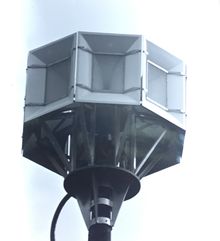
| |
| Company | Southern California Edison |
|---|---|
| Produced | 1982-1988 |
| Type | Electromechanical |
| Sound output | 120 dBc at 100 feet |
| Frequency | 240 or 300 Hz |
| Horsepower | 2 (Rotor) 10 (Blower) |
The SoCal Edison (SCE) 120 or Model 120 was a 120 dB low tone supercharged electromechanical siren designed in house by Southern California Edison for use within the 10 Mile Emergency Planning Zone (EPZ) for the San Onofre Nuclear Generating station .
History
The Model 120 was originally created in 1982 as a custom built siren for the SONGS plant, which had strict requirements for its siren system. SONGS had gone through two other systems before this point, with a system of 39 Sentry Siren Incorporated 10V's, 5V's, and 3V8's installed in August 1981 and tested January 25th thru 27th, 1982. The Sentry sirens were found to perform terribly compared to what was advertised, leading to the sirens being removed an replaced. SONGS would then install a new system of 39 Federal Signal STL-10's with those being installed by April of 1982 and tested in May of the same year. While the STL-10's performed significantly better than the Sentry sirens did, they still didn't meet the plant's needs. The only sirens on the market with enough range that would meet the plant's needs at the time were rotational sirens, but SONGS wanted to use exclusively omnidirectional sirens. So, they decided to design and create their own siren to meet their requirements.
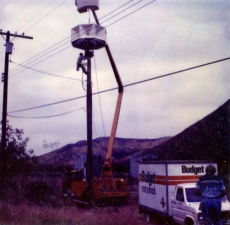
Starting in around June 1982, Model 120 prototypes started to be constructed and tested, with the final designed units being completed in October 1982. Originally, the plan was after the first Model 120's were installed, a total of 52 additional Model 120's were going to replace the existing Federal Signal STL-10's and making the system entirely Model 120's. This plan was dropped shortly afterwards due to the increasing delays and costs caused to the plant by not having a ready siren system by 1981 which was the original year planned for the plant's 2 newly constructed reactors to begin operating. Units #2 and #3 were ready to begin operation, but because the siren system was inadequate they couldn't begin operation until the Model 120's were installed. This caused a delay for over a year, as it also happened around the same time the NRC required nuclear plants to have siren systems. This also meant the plant's existing Unit #1 could not be restarted until the siren system was ready.
There were 22 of these sirens produced, with one being never installed and put into storage as a spare. 16 of these were installed in October 1982 to add into the system of STL-10's, 8 of which indirectly swapped out with Model 120's with another 8 being brand new installs. 5 additional sirens were installed in 1988, one of which replaced a Federal Signal Thunderbolt that was an existing Civil Defense siren.
After the Model 120's went up, in order to end the delays of the siren system not being up to par, SONGS opted to just keep the remaining Federal Signal STL-10's and add 21 Model 120's in areas that need coverage and to swap out specific STL-10 sites that had the worst range compared to the others, (First 8 sites), to get the EPZ up to code for the plant's reactors to start. After a successful system test on May 4th, 1983, the plant's new reactors began operation shortly afterwards with Unit #2 starting on August 8th, 1983, and Unit #3 on April 1st, 1984, as well as Unit #1 being restarted. These delays, and the cost of the sirens themselves cost the plant over $1 million dollars.
Other Information
For around a decade, they were thought to be "Toshiba" sirens, because they were pneumatic and people just assumed they were made by Toshiba which made pneumatic sirens. The Model 120 is a Supercharged Electromechanical siren, but also more or less acts like a pneumatic siren due to the rotor lacking any vanes, meaning it requires an external air source to produce any meaningful sound, such as the Thunderbolt and Hurricane. The sound is created by a 4-port (later 5-port) single tone rotor, which spins inside the stator, which acts as a chamber to contain the air inside. The rotor is driven by a 2 Hp TEFC motor that runs at 3450 RPM. The siren has an 8-port stator with narrow ports, and the sound is then projected by 8 large fiberglass horns attached to the stator. The siren makes use of a belt driven Paxton centrifugal blower, that uses a 10 Hp TEFC motor which sits below the siren's head to force pressurized air up into the rotor. The 4-port units reached a frequency of 240 Hz (480 Hz without the blower) and the 5-port units reached 300 Hz. The rotor and stator are both coated in Teflon, which helps seal the air in and prevent leaks, while also helping to protect them from corrosion from the salty air. The rotor is 9.75 inches in diameter and including the stator, which it alone is over 2 inches in diameter, is in total 11.75 inches in diameter.
By June of 2004, the plant began discussing a system replacement project due to the sirens suffering from advanced corrosion and degrading reliability due to the system's proximity to the ocean, along with the system "aging", and a year later starting In November 2005, (a month after the annual siren test), the Model 120's and the STL-10's started to be gradually removed and replaced, and by February 2006 all have been replaced marking October 26th, 2005 as the final test of the original system, as well as the end of the one of a kind original system that stood out from all other Nuclear plant systems. Whelen Engineering WPS-2810's and WPS-2806's were installed in their places. The 2810's went in place of the Model 120's and the 2806's went in place of the STL-10's.
These new electronic sirens have battery backup, are less maintenance due to their resistance to corrosion and no moving parts, and have similar ranges to the original system such as the 2806's having better range compared to the STL-10's, and the 2810's having close to the same range but about 2,000 feet less range compared to the the Model 120, but still enough range to cover the EPZ. These new sirens met the strict requirements of the plant without the need to specifically design a new siren as by the 2000's, there was commercially produced omnidirectional sirens that have close to the same range as the Model 120 and as well have better range then the STL-10's.
After all the old sirens have been removed and replaced, SONGS sold 23 of the STL-10's to Curry County, Oregon to be used as tsunami sirens, 8 of which were installed, and the Model 120's and remaining 5 STL-10's are believed to have been scrapped, but its unknown if they were, or went somewhere else but hasn't been discovered. The only Model 120 that is known and remaining is in private possession currently under restoration to be brought back into operating condition.
Gallery
-
7 Model 120 heads and blowers prior to being assembled.
-
Assembled unit without horns.
-
Horns being attached and conduits ran to main junction box.
-
5 out of the 8 horns attached with another unit being assembled off to the left.
-
Closer view of the head with the siren 95% assembled.
-
Fully assembled Model 120.
-
Fully assembled Model 120 with the other 6 being assembled and crated up to be transported to San Onofre Nuclear Generating Station for installation in the 10 mile EPZ in October 1982. These were the first 7 to be installed which replaced 7 STL-10B's.
-
Siren Location SC-13 illuminated by a spot light at night in 2003. The siren was 21 years old at the time.
-
Head of the privately owned unit with a salvaged motor attached.
See Also
- Siren patent: https://patents.google.com/patent/US4649853
- Model 120 head run up: https://www.youtube.com/watch?v=mf7YC0Vc_ZI
- Model 120 head dissembled: https://www.youtube.com/watch?v=yOcVk3SrqtY
